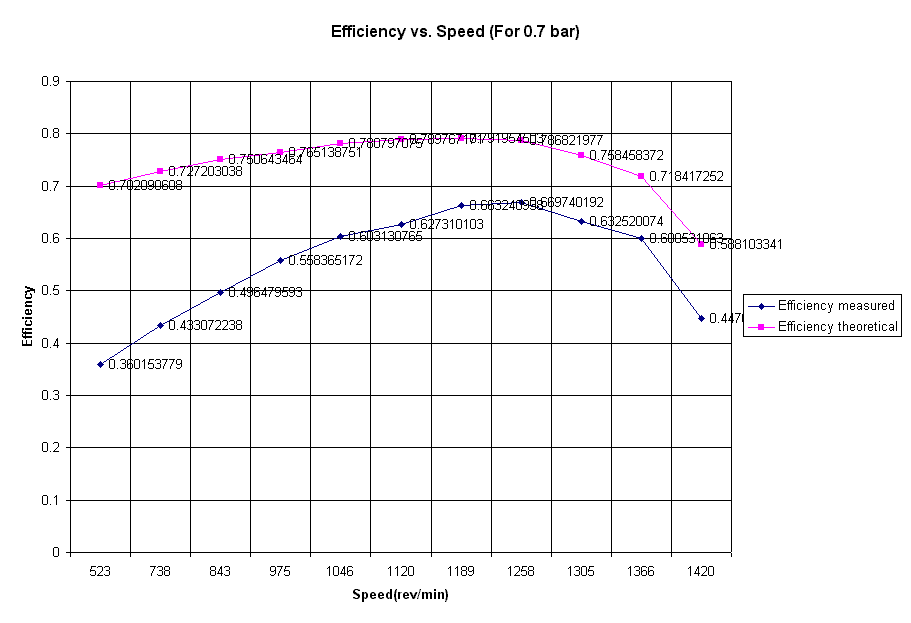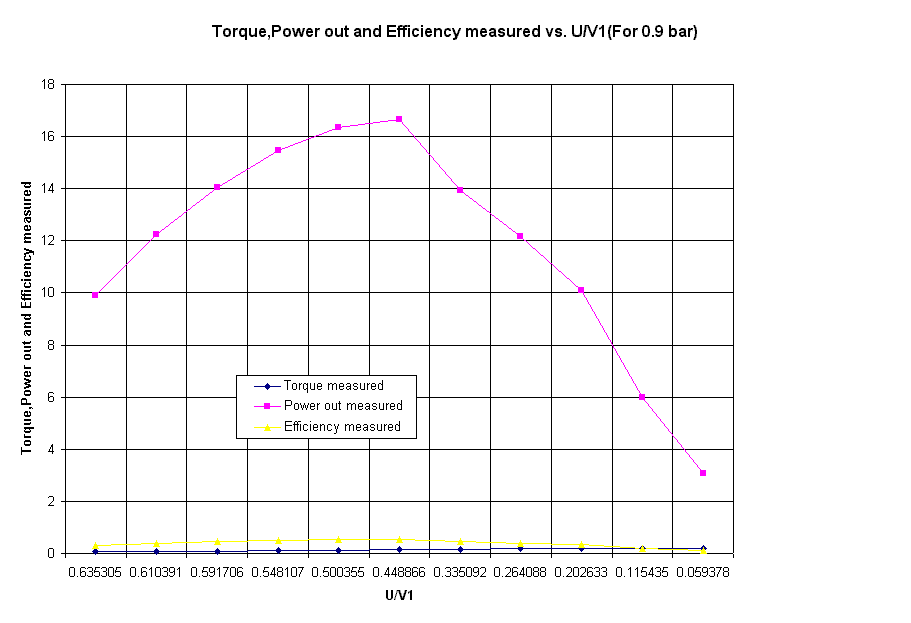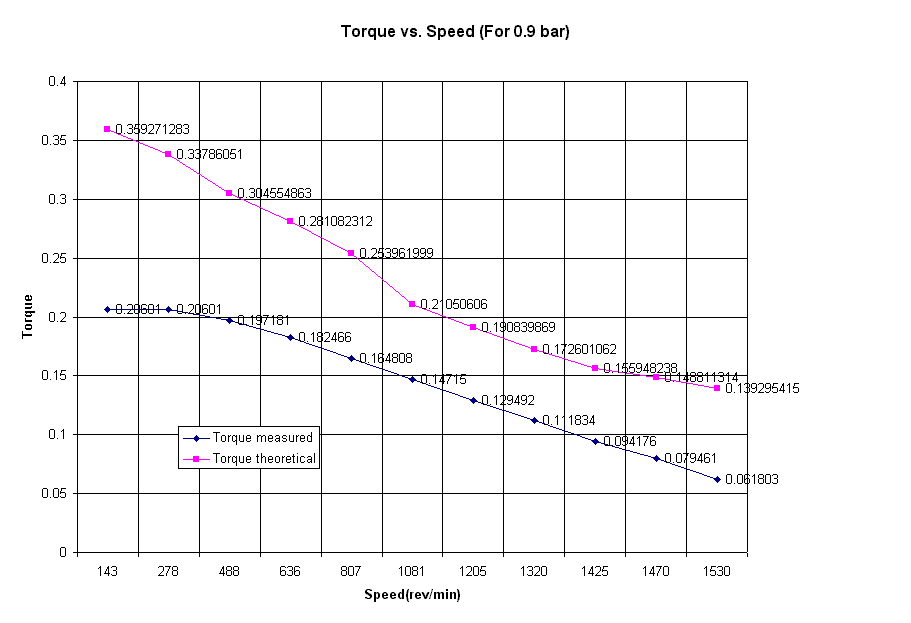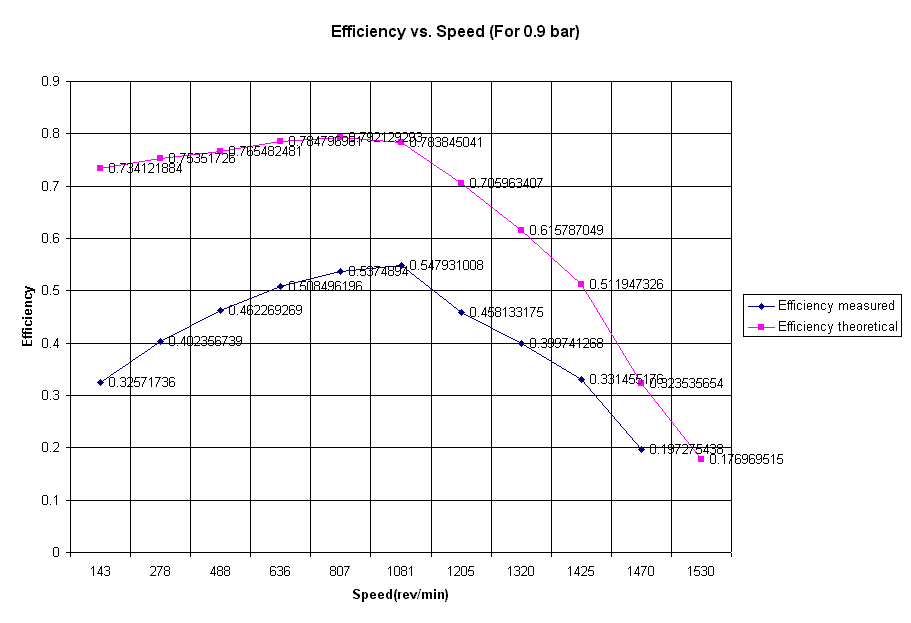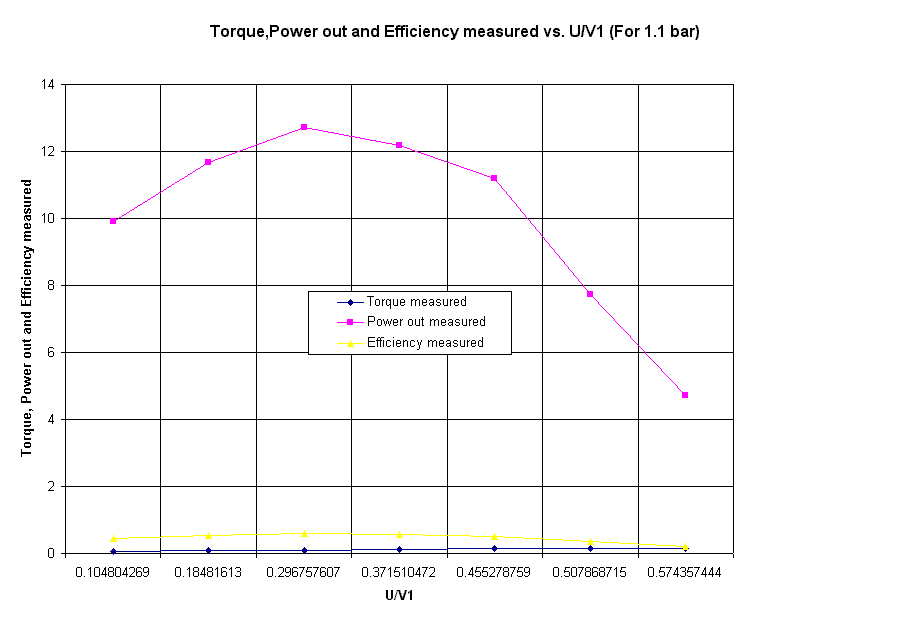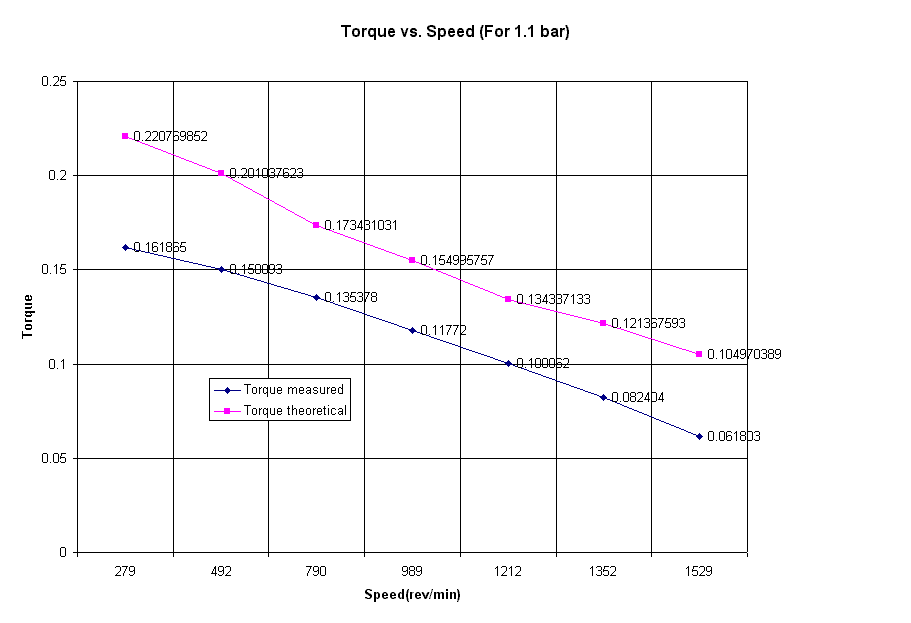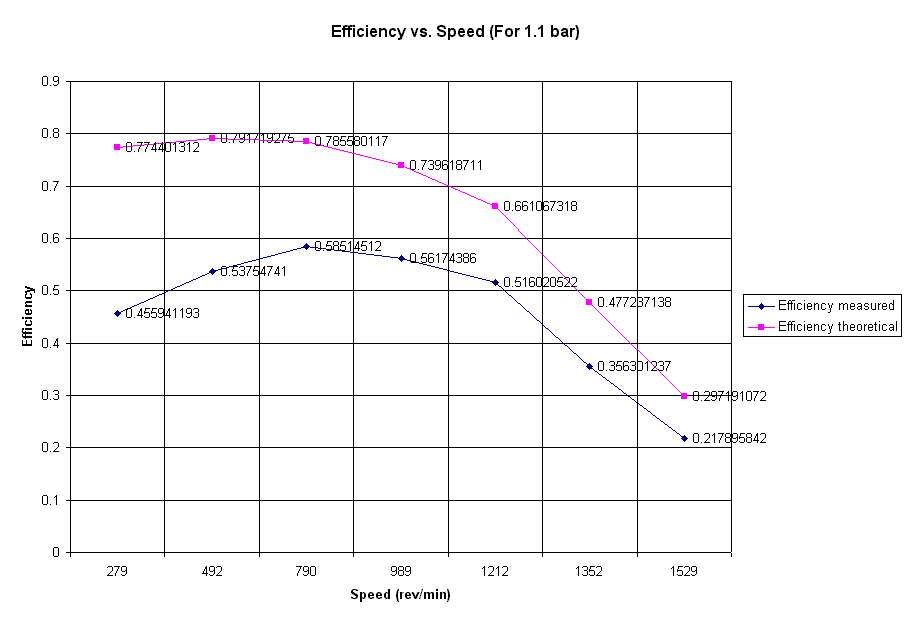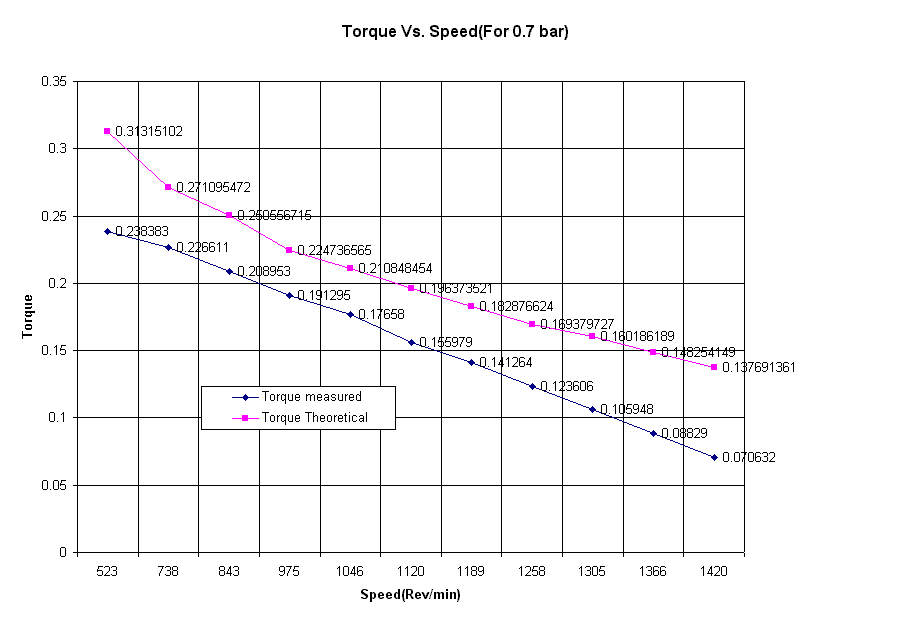
Title of Experiment : Pelton Wheel Turbine
Course
No: MEHB331
Section:***
Day
Experiment performed: 99
Lecturer:
***
Purpose/
Objectives.
The objective of the experiment is to investigate the performance of the Pelton Wheel turbine with different range of flow rates and rotational speeds.
Data/ Observation
and Results.
Pelton Wheel Results
Sheet:
Inlet Head, H= 7.1356
m
Volume of water
collected, Vol=25liter
Discharge, Q= 25
liter/min
Power Input,Win=
29.167Watt
|
Weight W(grams) |
Tension S(grams) |
Speed w(rpm) |
Meas. Torque, tm
(Nm) |
Meas. Pow. Out Pout,m (Watt) |
Meas. Eff. hm≠≠ |
Theo. Torque tth (Nm) |
Theo Pow. Out Pout,th (Watt) |
Theo Eff. h≠th |
V1/U |
|
|
350 |
110 |
1420 |
0.0706 |
10.50 |
0.3602 |
0.1375 |
20.48 |
0.7021 |
1.4957 |
|
|
450 |
150 |
1366 |
0.0883 |
12.63 |
0.4331 |
0.1483 |
21.21 |
0.7272 |
1.5548 |
|
|
550 |
190 |
1305 |
0.1059 |
14.48 |
0.4965 |
0.1602 |
21.89 |
0.7506 |
1.6275 |
|
|
650 |
230 |
1258 |
0.1236 |
16.29 |
0.5584 |
0.1694 |
22.32 |
0.7651 |
1.6883 |
|
|
750 |
270 |
1189 |
0.1413 |
17.59 |
0.6031 |
0.1829 |
22.77 |
0.7808 |
1.7863 |
|
|
850 |
320 |
1120 |
0.1560 |
18.3 |
0.6273 |
0.1964 |
23.03 |
0.7898 |
1.8964 |
|
|
950 |
350 |
1046 |
0.1766 |
19.34 |
0.6632 |
0.2108 |
23.10 |
0.7920 |
2.0305 |
|
|
1050 |
400 |
975 |
0.1913 |
19.53 |
0.6697 |
0.2247 |
22.95 |
0.7868 |
2.1784 |
|
|
1150 |
440 |
843 |
0.2090 |
18.45 |
0.6325 |
0.2506 |
22.12 |
0.7585 |
2.5195 |
|
|
1250 |
480 |
738 |
0.2266 |
17.52 |
0.6005 |
0.2711 |
20.95 |
0.7184 |
2.8779 |
|
|
1350 |
540 |
523 |
0.2383 |
13.06 |
0.4477 |
0.3132 |
17.15 |
0.5881 |
4.0610 |
|
Inlet Head, H=9.1743
m
Volume of water
collected, Vol=25liter
Time taken, t=74s
Discharge, Q= 20.27
liter/min
Power Input,Win=30.405
Watt
|
Weight W (grams) |
Tension S (grams) |
Speed w (rpm) |
Meas. Torque tm
(Nm) |
Meas. Pow. Out Pout,m (Watt) |
Meas. Eff. hm≠≠ |
Theo. Torque tth (Nm) |
Theo Pow. Out Pout,th (Watt) |
Theo Eff. h≠th |
V1/U |
|
|
350 |
140 |
1530 |
0.061803 |
9.903 |
0.3257 |
0.1393 |
22.32 |
0.7341 |
1.5740 |
|
|
450 |
180 |
1470 |
0.079461 |
12.23 |
0.4024 |
0.1488 |
22.91 |
0.7535 |
1.6383 |
|
|
550 |
230 |
1425 |
0.094176 |
14.05 |
0.4623 |
0.1559 |
23.27 |
0.7655 |
1.6900 |
|
|
650 |
270 |
1320 |
0.111834 |
15.46 |
0.5085 |
0.1726 |
23.86 |
0.7848 |
1.8245 |
|
|
750 |
310 |
1205 |
0.129492 |
16.34 |
0.5375 |
0.1908 |
24.08 |
0.7921 |
1.9986 |
|
|
850 |
350 |
1081 |
0.14715 |
16.65 |
0.5479 |
0.2105 |
23.83 |
0.7838 |
2.2278 |
|
|
950 |
390 |
807 |
0.164808 |
13.92 |
0.4581 |
0.2540 |
21.46 |
0.7060 |
2.9843 |
|
|
1050 |
430 |
636 |
0.182466 |
12.15 |
0.3997 |
0.2811 |
18.72 |
0.6158 |
3.7866 |
|
|
1150 |
480 |
488 |
0.197181 |
10.07 |
0.3315 |
0.3046 |
15.57 |
0.5120 |
4.9350 |
|
|
1250 |
550 |
278 |
0.20601 |
5.998 |
0.1973 |
0.3379 |
9.84 |
0.3235 |
8.6629 |
|
|
1350 |
650 |
143 |
0.20601 |
3.085 |
0.1015 |
0.3593 |
5.38 |
0.1770 |
16.841 |
|
Inlet Head, H= 11.21
m
Volume of water
collected, Vol=30liter
Time taken, t=152s
Discharge, Q= 11.84
liter/min
Power Input,Win=
21.707Watt
|
Weight W (grams) |
Tension S (grams) |
Speed w (rpm) |
Meas. Torque, tm
(Nm) |
Meas. Pow. Out Pout,m (Watt) |
Meas. Eff. hm≠≠ |
Theo. Torque tth (Nm) |
Theo Pow. Out Pout,th (Watt) |
Theo Eff. h≠th |
V1/U |
|
|
350 |
140 |
1529 |
0.061803 |
9.897 |
0.4559 |
0.1050 |
16.81 |
0.7744 |
1.7411 |
|
|
450 |
170 |
1352 |
0.082404 |
11.66 |
0.5375 |
0.1214 |
17.19 |
0.7917 |
1.9690 |
|
|
550 |
210 |
1212 |
0.100062 |
12.70 |
0.5851 |
0.1343 |
17.05 |
0.7856 |
2.1965 |
|
|
650 |
250 |
989 |
0.11772 |
12.19 |
0.5617 |
0.1550 |
16.05 |
0.7396 |
2.6917 |
|
|
750 |
290 |
790 |
0.135378 |
11.20 |
0.5160 |
0.1734 |
14.32 |
0.6611 |
3.3698 |
|
|
850 |
340 |
492 |
0.150093 |
7.734 |
0.3563 |
0.2010 |
10.36 |
0.4772 |
5.4108 |
|
|
950 |
400 |
279 |
0.161865 |
4.729 |
0.2178 |
0.2208 |
6.45 |
0.2972 |
9.5416 |
|
|
1050 |
0 |
0 |
- |
- |
- |
- |
- |
- |
- |
|
|
1150 |
- |
- |
- |
- |
- |
- |
- |
- |
- |
|
|
1250 |
- |
- |
- |
- |
- |
- |
- |
- |
- |
|
|
1350 |
- |
- |
- |
- |
- |
- |
- |
- |
- |
|
Calculation
for measured value:
Head, H=(P*105)/rg
Discharge, Q=*(Vol/t)*60 liter/min
Power output, Wout,m=tm*w*2*p/60 Watt
Efficiency, hm=Wout,m/Win
tm=[(W-S)/1000]*g*Rd
where Rd=radius of dynamometer wheel=0.03m
W=Applied weight in grams
S=Tension gauge reading in grams
Win=(P*105)(Q*10-3)/60 Watt
U/V1=w*R*2*p/{(Cv[2*g*H]1/2)*60} Watt
Where R=0.05m
Cv=0.94
w=speed rpm
Calculation
for theoretical value:
tth=(rQ*10-3/60)*(Cv*[2gH]1/2-(wR2p/60))*(1+k1cosq)*R
with k1=0.8
q=250
Wout,th=tth*w*2*p/60 watt
hth=Wout,th/Win
Analysis and
Discussion
The wheel is connected to a string which will be loaded with weights in order to apply a torque to the wheel. When the flow is set to a certain flow rate, the flow will rotate the wheel by means of transferring the momentum through the cups connected to the wheel. When the loads is increased, the wheel will be harder to rotate due to the increase in torque applied to the wheel. From the data, graphs of Torque, power output and efficiency vs. U/V1 is plotted and the value of power output is increasing to a certain point and then it starts to decrease and the efficiency behaves in similar manner as well while the torque increase. Relatively, the 0.7 bar flow rate will give a higher efficiency followed by the 0.9 and 1.1 bar.
From the torque vs. speed graphs, we can see that the speed decrease proportionally with increasing torque and relatively, the 0.7 bar flow rate will have more force to to move the wheel thus will have the highest speed compared to the 0.9 bar and 1.1 bar flow.
From the efficiency vs. speed graphs, it is found that the measured efficiency is lower than the theoretical which is due to the fluid friction which reduces the kinetic energy of the flow. As the speeds increase, the efficiency increase too until to a certain point, it will decrease meaning that the efficiency of the wheel will decrease eventually and it is impossible to reach an increasing efficiency based on the theoretical value.
Conclusions.
As a conclusion, we found that the Pelton wheel performance is higher for a higher flow rate given at a lower pressure. From the experiment, the 25 liter/min flow rate gives the highest performance and efficiency followed by the 20.27 liter/min and 11.84 liter/min. Relatively, the efficiency of the 25 liter/min flow rate is higher than the other two flow rate. From the rotational speed point of view, the efficiency of the wheel is the highest at the point of average of overall speed recorded. For the 25 liter/min flow rate, the efficiency is highest at 975rpm for a range of 523-1420rpm speed. For the 20.27 liter/min flow rate the efficiency is highest at 1081rpm for a range of 143-1530rpm speed and for the 11.84 liter/min the highest efficiency is highest at 279rpm for a range of 279-1529rpm speed.

